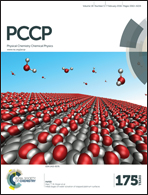The formation of heterointerface defects in Au/Cu films on Si substrates under direct current in a vacuum ultraviolet environment†
Abstract
Au/Cu metallic films were deposited on p-Si(100) substrates with and without an Au upper layer by magnetron sputtering. The defect formation and nanoscale interfacial evolution at the Au/Cu and Cu/Si interfaces were studied by using Auger electron spectroscopy (AES) and high resolution transmission electron microscopy (HRTEM). The results showed that an increase in defects at the heterointerfaces and in the surface layer was induced by the effect of a direct current (DC) in a vacuum ultraviolet (UV) environment, which could provide more channels for the removal of atoms. The directed migration of atomic clusters in the films was caused by the effect of the DC, which also aggravated the defects’ expansion and led to the formation of Au–Cu intermetallic compounds (IMCs). In addition, the voids formed at the interface between the Au/Cu films and the Si substrates were found to be mainly related to the generation of the material Au2Cu3.


 Please wait while we load your content...
Please wait while we load your content...